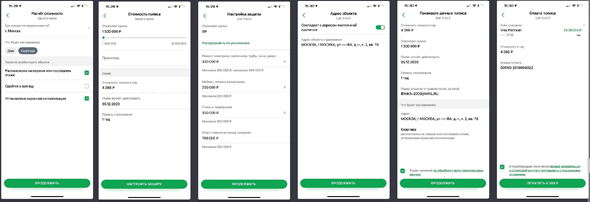
The figure shows a prototype of a product for Sberbank Online.
There are different techniques for researching and improving customer experience (CX). Today we will tell you about one of them - design thinking, and Irina Bazhenova, an expert in customer experience research at Sberbank, will help you with this.
Before CX, Irina worked in the retail branch of the very same Sberbank, when savings books were in use, without which the deposit could not exist. The client could accidentally spoil a paper book - wet it, for example, then it had to be changed. It could just end, and then, if suddenly someone remembers, a stamp was put, and the owner had to write by hand the amount at which his book ended in order to transfer everything to a new penny. Of course, someone was mistaken, it was generally very difficult for pensioners to write by hand. The main question that arose then for Irina: why should I, as a specialist, ask our client to do this? After all, it is difficult for him to do this. And what is the practical use of this? There were quite a few similar situations. But then the bank was different, and the legislation.
Agile transformation began at Sberbank in 2016. At the same time, they began to actively implement the design thinking methodology for designing customer experience. In the first years, almost all projects were aimed not at researching new products, but at correcting some features of old ones. Well, you know, like the one that "where the card was opened, go to that department."
So it is tested in practice: the earlier you do the research and talk with the client, the less costs will be further in the development and launch of the product. And, in fact, this is precisely why it makes sense to embed processes for studying customer experience into the development itself. If you think about the client only when there is already a prototype, then these are already ineffectively spent resources.
A little about the technique
Design Thinking is an approach to designing solutions and products that focuses on understanding human needs.

The technique is visualized as follows:

Let's look at an example
Irina received a request for help in modifying the Home Protection product. This is Sber's insurance for an apartment, summer house or private house for individuals. At the entrance, the team had a boxed version of the product with three options for insurance amounts, prices and distribution of insurance limits. As a result, the team wanted to have an online constructor that could be integrated into the Sberbank Online application. This would allow clients to independently choose their insurance options and thereby improve the further client experience when applying for a payment.
A design thinking project always starts with building a team. It is impossible to walk this path alone. It is better to create a team from employees of different departments who are important and interested in the topic being worked out. The optimal team size is five to nine people.
The cross-functional team brought together nine people from different departments to solve this problem, including specialists in insurance products, marketers and IT developers.
The team formulated the problematic for the project and the main product topics that needed to be discussed in the interviews with the clients. And then the study began.
Step 1. Empathy
The team conducted six in-depth interviews in Moscow and five in other regions with clients who:
- / ;
- / .
As a result, the first hypotheses were obtained.
When preparing for in-depth interviews with clients, one may ask the question: how many interviews do you need to conduct in order to draw representative conclusions?
The answer is this: as soon as clients begin to repeat themselves in their stories, you can not conduct more interviews, since the time spent on the interview will not justify the information found.
Qualitative research allows you to find insights and identify existing problems and needs. Further, it is already possible to check every detail on quantitative studies.
The team did just that during this project and launched surveys, receiving 100 responses from clients from different regions and cities of different sizes.
Step 2. Analysis and synthesis
This step is needed to identify insight and customer need. First, you look for what surprised you during the research, during the conversation with the client. The team then chooses one specific thing that they want to work with. It can be anything you like regarding the client and the product. And then the experts use the "5 Whys" technique, that is, they ask questions to build a bridge to insight.
Insight is not what the client said directly, but what is behind it, because what the client thinks, does, feels and says are four big differences.
So, in our example, we met Polina, she is 32 years old, she lives in Samara with her son, she uses only SberBank from banks, since SberBank is a name with a long history. And so the team chose what "surprised" them.
Polina is more afraid of flooding her neighbors than herself.
Why? My team and I have generated various answers to this question, and as a result, we settled on this. It turns out that she does not know how much compensation for damage to neighbors may cost. That is, this combination of "surprise + insight" gave us the opportunity to move on to formulating the client's needs.
A need is formulated through a verb, and this should be needed by the client and should not be a solution. To create a mobile application and take out insurance is not a need, the client has a need to protect his home, to protect his property. We get:
Polina is more afraid of flooding her neighbors than herself, since she does not know how much compensation for damage to neighbors may cost. And it would be great for Polina to be sure of the amount that can be paid to neighbors, and to manage this amount itself.
And this combination - surprise + insight + need - enabled the team to formulate a feature.
Step 3. Generating ideas
So, in the way described above, we identified 10 key customer needs, generated about 180 ideas and did two prototyping iterations.
Step 4. Prototyping
They created a prototype, that is, they took A4 sheets of paper, tore them in half. Further, the team of participants in design thinking united into subgroups to draw the interface - application screens with buttons, as if the client wanted to issue "Home Protection".
The team drew 20 prototype screens, with the participants "thinking with their hands", putting themselves in the shoes of the client to display specific steps of the user.
By the way, in a remote environment, all these stages can also be implemented on an interactive whiteboard at Miro.com.
This stage is very important in design thinking, because with minimal resources you can immediately see how the product will look like. And since we have cross-functional teams with people from different departments, many process "buts" immediately pop up, which immediately allows us to formulate solutions for them. If you do not do this, then often a complex process appears instead of one button.
Step 5. Testing
Then the "prototype on paper" is tested by a team with clients. Our "testers" were very happy, because they had the opportunity to take a pen, draw, cross out something and show that they feel comfortable like this, and not like this. We finalized the prototype and carried out two more iterations.
This entire project took about 50 hours of collaboration, from interviews to prototyping and testing. During this time, the team formed a complete vision of the future product and tested it with clients. Only after that did the immediate implementation begin.
What happened?

Sberbank Online - Catalog - "Home Protection".
On the third screen, it is possible to adjust the amount based on what the client needs. In this case, Polina would correct the amount of responsibility to neighbors, make it, for example, the maximum possible in her case.

After the launch of this product in this form in Sberbank Online, the number of contracts increased by 41% in July 2020 compared to May 2020.
Why is it important to conduct research in cross-functional teams?
Radical collaboration in cross-functional teams is a proven design thinking principle. This is a good way to bring the product team together. This is an opportunity to place the performers and customers of the product in a single context, which in the future allows you to quickly coordinate any changes. And as a result - to accelerate the delivery of value to the client.
How to choose the right time and format for a CX study?
The first two stages of the methodology are suitable in order to diagnose the use of the product and identify the pains of customers and their needs for using the product.
If the product already exists but needs to be improved. For example, if you find pain points, identify insights, customer needs and make a list of ideas for improving a product, then the third step for generating ideas is connected to the first two steps.
When there is a prototype that needs to be tested, or a hypothesis that needs to be tested, then in order to determine whether the chosen direction is correct, refer to testing. Typically, it will take several iterations, so it's obvious to go back to prototyping.
Thus, design thinking can be applied at any stage of the product life cycle, but it is much more effective to start creating a product with empathy.
Thanks to Irina Bazhenova, neurocoach, UX research leader of the Corporate and Investment Business block at Sberbank, certified trainer and design thinking facilitator for an interesting story, materials and help in preparing the article.